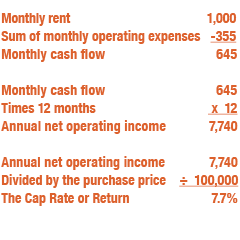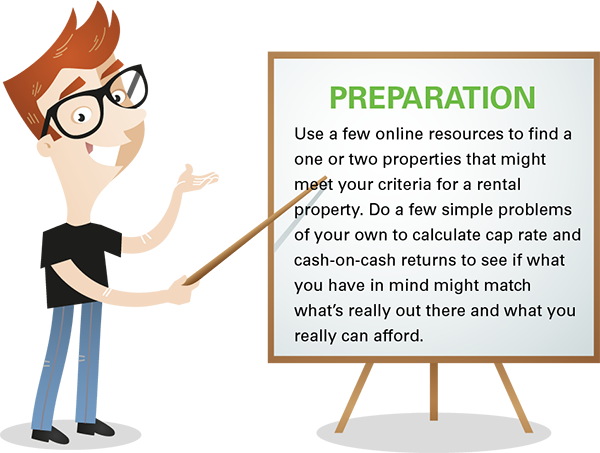Making an Offer

Perhaps the most exciting part of the transaction is making the offer. But what is the ideal amount to offer? You want to get the lowest price possible but you also want to make sure the seller accepts your proposal. You can submit an offer and the seller will accept it, reject it or make a counter-offer. This back and forth with counters can sometimes take several days, but before you get to the offer stage you need to run your numbers and then run them again to make sure your offer helps you reach your goals. And whatever you do, make the offer with your head and not your heart.
Valuation Methods |
Method One: Return on Investment
The return on investment method focuses on what the property will yield as a result of the money you invested. It’s an investment so this makes all the sense in the world! Measuring return usually is a snapshot of profitability and cash flow and the first metric we need to understand is the capitalization rate.
The capitalization rate is the ratio between the net operating income produced by a property and the original price you paid, expressed as a percentage. Does that sound a little complicated? Don’t worry it’s not complicated mathematics but the assumptions are important.
Assume the asking price from a property is $100,000 and it’s renting for $1,000 per month. Let’s assume annual property tax is $1,000, which is $80 per month. Your landlord insurance policy is $45 per month and your property manager charges 10% of gross rent received so that’s $100 per month, and you allocate $130 per month for vacancy and repair expenses. Your total monthly expenses would be $355 and monthly income and cash flow is $645. Cap rates measure the annual net operating income produced by a property as a percentage of the original price paid. In this case it’s $7,740 divided by $100,000, which is a 7.7% return.
Once you have a cap rate you can move on to look at the opportunity to get financing and borrow some of the purchasing funds and look at cash-on-cash return. The cash-on-cash return is the ratio of annual before-tax cash flow to the total amount of cash invested, expressed as a percentage. It’s just like the cap rate but you have less money invested and added a mortgage payment.
Assume you decide to borrow 75% of the purchase price and place 25% down as deposit. With closing costs of $3,000 your out-of-pocket cash is $28,000 with a mortgage of $75,000. Your new mortgage payment is $402 per month and with that additional expense you will clear $243 of cash flow per month, or $2,916 per year. Now to measure your cash-on-cash return, simply divide your annual cash flow of $2,916 by the total cash invested of $28,000 and voila, your cash-on-cash return is 10.4%. By borrowing at a lower rate than your cap rate you use less funds to buy the property and your return significantly increases and makes the list price or your offer od $100,000 more attractive if the seller will accept an offer with a financing contingency. Depending on market conditions it maybe better to make an offer with a mortgage at the $100,000 asking price then buy for all cash but request a $5,000 discount!
I believe all buy and hold properties should be purchased based on cap rate and cash on cash returns. However it’s also good to know what similar homes are selling for and appreciation potential.
For a full breakdown of these calculations please re-visit Lesson 3 Measuring Return Cap Rates and Cash on Cash
The Auto Investment Property Calculator will forecast your cash flow now and calculate your cap rate too!
Method Two: Sales Comparison
The sales comparison method “running comps” is one of the most common ways of valuing residential real estate. This approach is simply a comparison of similar homes that have sold recently.
Price per square foot is a usual metric that all investors can use to determine where their property should be valued. If a 1,250 square foot townhome is sold for $80 per square foot then the price is around $100,000 and can expect similar houses to sell in that range. But what is a similar property? This method is very generic and doesn’t take into consideration the driving forces being occupancy and how much a place will rent for. For example, number of bedrooms, bathrooms proximity to transport, parking and modern facilities all combine to define the overall attractiveness to renters.
Market Rent

Upgrades and Repairs

You may want to charge $1,200 per month for a tidy profit but can you get that? To determine a fair market rent, start with what the renters are paying now and compare with other rentals in the area. You can do this on your own or with the assistance of a real estate agent but rental properties listed in the MLS will show what the home is bringing in each month for rent. We’ve pulled some market data into our app to help you estimate rents, too.
If rental information isn’t readily available or the property you’re considering is not being rented currently you may need to enlist the services of a real estate appraiser who can perform a market rental analysis. This amount will appear as an addendum to your property appraisal that the lender orders but if you want to know the amount ahead of time contact an appraiser. You also can check out many online resources and filter by location and number of bedrooms:
When you first visit the property, pay close attention to the Seller’s Disclosure report which will list any items that need repair and consider those costs when making your offer. Once you make your first tour through the home, schedule another. You want to have another visit to make sure there weren’t any items you missed.
If the seller is available ask what could use some repairs around the house or are there issues that need immediate attention. If the seller isn’t available, the listing agent will have the information for you. If there are costs for repairs, make sure you have enough funds available for them along with a maintenance account to take care of the unexpected. Again, remember it’s the math that tells you whether or not it’s a good deal. If you begin to get too attached to the property emotionally it can cloud your judgment.
The Final Analysis |
Your offer should be determined whether or not the property cash flows. If you find the counters going back and forth the monthly payments will change, yet if the counter offers are rather benign, say a few hundred dollars, your cash flow won’t be greatly affected. If you determine that cash flow and holding costs are very close to one another, the numbers don’t work out and you should move to the next prospect.
The Bottom Line
All rental properties are not the same. Location and age of property are key considerations for cost of ownership and savvy investors will look at components from these valuation methods before making an offer. You may find that only one in 10 properties work out in the way you want but that’s really okay. Go over your numbers several times to make sure they’re correct and then make your offer.
SUMMARY
- There are two valuation methods – measuring return and completing comparison analysis
- Financing costs including down payment and terms should be prepared before any offer
- Research market rents for the area, hire an appraiser if the numbers aren’t clear
- Consider and repairs and upgrades and how much you’ll need to fix them
- Let the numbers decide for you, don’t lead with your heart





